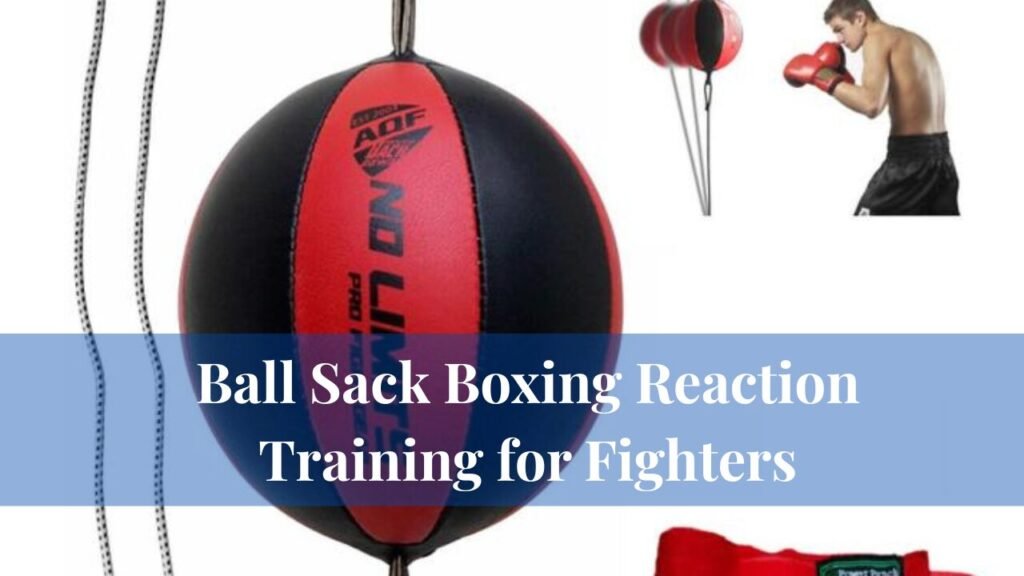When it comes to training like a professional boxer, one tool that’s gaining massive popularity is the ball sack boxing bag. Don’t let the name mislead you; it’s not a joke. This unconventional yet powerful piece of training equipment is transforming reflex and reaction training in boxing, MMA, and fitness communities.
Whether you’re aiming to enhance your hand-eye coordination, sharpen your reaction time, or refine your footwork, a ball sack boxing setup can provide significant benefits. Its unique design challenges your skills in ways traditional equipment cannot. In this article, we will explore how this distinctive tool works, why professional fighters incorporate it into their routines, and how you can integrate it into your own training to maximize performance in the ring.
What Is Ball Sack Boxing?
Ball sack boxing refers to a specialized form of reflex and reaction training that uses a double-ended or hanging ball designed to improve speed, timing, and precision. These balls are usually suspended from a frame, ceiling, or freestanding support, allowing them to swing and move unpredictably. This unpredictability creates a challenging stimulus that requires the athlete to stay alert and respond instantly.
Unlike conventional heavy bags, which primarily absorb powerful strikes, the ball sack emphasizes subtle, technical aspects of boxing. The focus is on tracking a moving target, reacting quickly, and adjusting body positioning and punches in real time. The training is less about brute force and more about refining the skills that distinguish elite fighters.
This approach develops several essential skills including reaction speed, timing, precision punching, and defensive movement such as slipping, ducking, and weaving. While the name may sound humorous, the equipment is taken seriously by athletes of all levels who seek to improve reflexes, coordination, and defensive capabilities.
Key Benefits of Ball Sack Boxing Training
Incorporating ball sack boxing into your regimen offers multiple proven benefits that can elevate your performance.
Enhanced reflexes are among the primary advantages. The unpredictable swinging motion of the ball forces the nervous system to process movement rapidly. Over time, your brain becomes more adept at tracking and anticipating motion, translating into faster reactions to an opponent’s strikes during a real match.
Hand-eye coordination also improves significantly. Consistently hitting a moving target strengthens the connection between visual input and motor response. This allows your body to respond with precision, ensuring that your punches land exactly where intended. Developing this skill enhances counterpunching efficiency and overall offensive accuracy.
Accuracy and precision are naturally enhanced through ball sack training. Traditional heavy bags are large, static targets that tolerate less-than-perfect strikes. In contrast, a moving ball exposes even minor errors in targeting. Missing the ball becomes immediately evident, compelling you to adjust and strike with exactness, reinforcing the muscle memory needed for competitive bouts.
Defensive movement is another critical area strengthened through this training method. A ball sack is not solely for offensive practice; it is invaluable for defensive drills. The ball’s rebound simulates an opponent’s counterattack, encouraging slips, ducks, and head movement. Developing these defensive habits in a controlled environment ensures that fighters remain agile and responsive during actual matches.
Footwork and agility are also enhanced, particularly when using freestanding models that allow movement around the target. Maintaining balance, shifting weight, and adjusting positioning while reacting to the ball strengthens mobility and promotes a fluid, well-rounded fighting style. Improved footwork ensures better positioning for both attack and defense, a hallmark of advanced athletes.
Types of Ball Sack Boxing Equipment
Several types of ball sack equipment cater to different training needs and environments.
Double-end balls are the most common and versatile option. Suspended from both the ceiling and the floor using elastic cords, these balls rebound quickly after each hit. This dynamic motion is ideal for developing rhythm, timing, and accuracy. Double-end balls are suitable for both beginner and professional boxers due to their adaptability and durability. Popular products include Amazon’s Double End Ball Training Equipment, which provides adjustable tension and robust construction for long-term use.
Aqua reaction balls offer a unique alternative. Filled with water, these balls mimic the feel of a human head more accurately than air-filled models. They provide natural resistance while absorbing impact, offering a realistic sensation when struck. Products such as the Aqua Training Bag Ball Series are designed to deliver consistent movement and shock absorption, enhancing the authenticity of training drills.
Freestanding reflex balls are ideal for home gyms or locations where ceiling anchors are not feasible. Mounted on flexible poles with spring-loaded bases, these balls return rapidly after contact. Freestanding models challenge the athlete to move around them, providing a combination of striking, defensive, and footwork training. eBay offers a range of freestanding reflex balls that are compact and easy to set up, making them suitable for temporary or small-space environments.
How to Train with a Ball Sack Boxing Bag
Effective training with a ball sack requires strategy, patience, and progression. Beginners should start slowly, tapping or gently striking the ball to become familiar with its movement. Gradually increasing speed and intensity allows the athlete to build coordination and confidence without sacrificing form.
Using both hands during training is essential. Alternating punches between left and right promotes ambidexterity, an invaluable trait in competitive boxing. Balanced hand use ensures that both sides of the body develop evenly, enhancing adaptability and performance in varied fight scenarios.
Combining offensive and defensive drills further amplifies the benefits. Integrating slips, ducks, and weaving into the routine replicates real match conditions. After landing a strike, practicing evasive movements helps the fighter anticipate counterattacks and respond intelligently, reinforcing a comprehensive skill set.
Training sessions should mirror the structure of real matches. Working in two to three-minute rounds with short breaks allows for focused practice while preventing fatigue from compromising technique. Maintaining proper form throughout each round is crucial to ensure effective skill development and reduce the risk of injury.
Real Fighter Feedback
Professional athletes often highlight the transformative effects of ball sack training. Michael Rios, a USA Boxing silver medalist, describes the tool as a “game changer” in his routine. According to Rios, consistent use of the double-end ball improved his reaction time in the ring by at least 30 percent, forcing him to remain alert, move his head intelligently, and respond swiftly to each stimulus.
Customer reviews also reinforce its effectiveness. The TRX Reflex Ball on Amazon boasts a 4.8-star rating from over 2,000 users, who praise its durability, realistic movement, and ability to enhance reflexes and timing. These endorsements provide strong evidence that ball sack training is valuable for athletes seeking measurable improvement.
Where to Buy Ball Sack Boxing Equipment
Ball sack boxing equipment is accessible through multiple online and retail sources. Amazon is a top choice for budget-conscious buyers seeking fast delivery and extensive user reviews. For premium options, AquaTrainingBag.com offers water-filled reaction balls designed for high-level training. eBay serves as a platform for finding specialized or discounted models, including freestanding options suitable for home gyms.
For beginners unsure of which model to select, starting with a double-ended ball is recommended. Its versatility makes it appropriate for all skill levels, providing a foundation that can later be expanded with water-filled or freestanding variations.
FAQs
Is ball sack boxing good for beginners?
Yes, it’s a great tool for beginners. It helps to improve reaction, coordination, and confidence. Begin at a slow pace and progress once you’re comfortable.
How long should I train with the ball per session?
Start with 10-15 minutes a day and gradually work up to 3-minute rounds with rest intervals just like a real match.
What size ball is best for training?
For beginners, medium sizes are often recommended. Small balls move faster and require greater precision, making them more challenging.
Can I install a double-ended ball at home?
Yes. All you need is a ceiling hook and a floor anchor. Many products come with complete installation kits.
Is it suitable for kids or youth boxers?
Definitely. Just make sure the height is adjustable and the tension isn’t overly tight. Supervision is recommended for children to avoid injury.
Conclusion
For those serious about improving reaction speed, accuracy, and agility, ball sack boxing equipment is an essential addition to any training regimen. It offers a cost-effective, practical, and highly effective method for developing skills that translate directly to performance in the ring.
Whether training for competitive bouts or enhancing home workout routines, the ball sack challenges the body and mind in ways that conventional equipment cannot. The key is to focus on speed, precision, and intelligent response rather than sheer power.
By integrating ball sack boxing into your regimen consistently, you cultivate the reflexes, coordination, and defensive awareness necessary to succeed as a well-rounded fighter. Explore more on Boxing Essential for detailed guides, product recommendations, and training tips to elevate your boxing practice and gain a competitive edge.=




